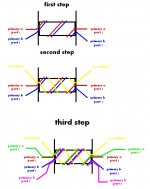Hi all
I'm totally new at smps circuits :ambivalence: ... Shift+R improves the quality of this image. Shift+A improves the quality of all images on this page.but like it alot .. now i would like to build up a 12vdc-220va power inverter using DC-DC converter then H-Bridge.
My only problem is i never wound a transformer .. i don't know how to make the calculations for the (ETD49/25/16 N87 525nH 0.5mm)----So please can i get some help here::SD ... Shift+R improves the quality of this image. Shift+A improves the quality of all images on this page.!!
I'm totally new at smps circuits :ambivalence: ... Shift+R improves the quality of this image. Shift+A improves the quality of all images on this page.but like it alot .. now i would like to build up a 12vdc-220va power inverter using DC-DC converter then H-Bridge.
My only problem is i never wound a transformer .. i don't know how to make the calculations for the (ETD49/25/16 N87 525nH 0.5mm)----So please can i get some help here::SD ... Shift+R improves the quality of this image. Shift+A improves the quality of all images on this page.!!

